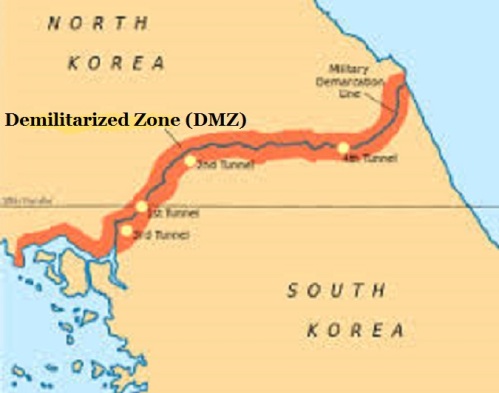David Alexander reports for Reuters that on Jan. 7, 2014, the Obama administration said the U.S. will send 800 more soldiers and about 40 Abrams main battle tanks and other armored vehicles to South Korea next month as part of a military rebalance to East Asia after more than a decade of war in Afghanistan and Iraq.
South Korea’s Yonhap news agency quoted military officials as saying that the new U.S. troops would be deployed in North Gyeonggi Province, just south of the demilitarized zone separating the two Koreas.
The battalion of troops and M1A2 tanks and about 40 Bradley fighting vehicles from the 1st U.S. Cavalry Division based at Fort Hood, Texas, will begin a nine-month deployment in South Korea on February 1.
A Pentagon spokesman said the personnel would remain for nine months but on departing would leave their equipment behind to be used by follow-on rotations of U.S. forces.
Army Colonel Steve Warren said, “This addition of forces to Korea is part of the rebalance to the Pacific. It’s been long planned and is part of our enduring commitment to security on the Korean peninsula. This gives the commanders in Korea an additional capacity: two companies of tanks, two companies of Bradleys.”
Barack Obama had announced a strategic rebalancing of U.S. priorities toward the Pacific in late 2011, while ending the direct U.S. military involvement in Iraq and planning to wind down the long U.S. engagement in Afghanistan.
Since the announcement of that so-called “pivot” in foreign, economic and security policy, the Philippines, Australia and other parts of the region have all seen increased numbers of U.S. warships, planes and personnel.
In a meeting in Washington on Jan. 7 with South Korean Foreign Minister Yun Byung-se, U.S. Secretary of State John Kerry tated the U.S. position on nuclear weapons in North Korea: “The United States and the Republic of Korea stand very firmly united, without an inch of daylight between us, not a sliver of daylight, on the subject of opposition to North Korea’s destabilizing nuclear and ballistic missile programs and proliferation activities.”
The United States has some 28,000 troops based in South Korea, which has remained technically at war with Communist North Korea since the 1950-1953 Korean conflict ended in stalemate.
The deployment of additional U.S. troops comes at a time of raised tensions on the Korean peninsula after North Korean leader Kim Jong Un executed his uncle Jang Song Thaek in the biggest political upheaval in years.
Donna Miles reports for American Forces Press Service, Jan. 7, 2014, that the rotational deployment of a cavalry battalion of about 800 soldiers from Fort Hood, Texas, to South Korea next month is in support of U.S. Forces Korea and 8th U.S. Army. Officials said that posturing a trained, combat-ready force in the region allows for greater responsiveness to better meet theater operational requirements.
The Army rotational deployments are just one aspect of the rebalance. Marine Rotational Force Darwin was the first new rotational arrangement in the Asia-Pacific region designed to bolster U.S. theater engagement. In April 2012, the first rotation of about 200 Marines was deployed to Australia just months after the U.S. and Australia had announced an initiative for Australia to host a U.S. rotational presence of a 2,500-member Marine air-ground task force that would exercise with the Australian defense force and train regional militaries.
In late September 2012, the second rotation of U.S. Marines wrapped up its six-month deployment to Darwin, with the third rotation to increase five-fold when it deploys this spring. About 1,150 members of Battalion Landing Team, 1st Battalion, 5th Marines, are scheduled to deploy from Camp Pendleton, Calif., complete with an infantry battalion, logistics and aviation detachment.
Meanwhile, the Navy has started littoral combat ship rotations in Singapore. USS Freedom completed its first rotation in November 2012, basing its operations at Singapore’s Changi Naval Base after its arrival in April.
Navy Adm. Samuel J. Locklear III, the U.S. Pacific Command commander, is a big fan of rotational units, which he said provide an “uptick in presence” that complements that provided by the 330,000 service members permanently based within the Pacom area of responsibility.
Locklear said, “What they provide is an ability to work with our allies and to leverage the capabilities of the allies across all aspects of peace to conflict,” Rotational forces also provide a regional presence that could pay dividends if the United States had to flow more forces into a particular area to protect the interests of the United States and its allies. (Hint: China!)



…and cue the histrionic hyperbole from the world’s oldest baby-country whining about this being an act of war that will be countered with crushing force.
LikeLike
Reblogged this on Brittius.com.
LikeLike
Thank you StMA for this significant post. The timing is noteworthy, given the fact that North Korea’s “king” is a psychopath.
LikeLike
And Obama sent 30,000 troops to Afghanistan when he did not support the surge. 800 troops and 40 Bradleys, not enough to reinforce and too many to lose. Could they not be possibly be abandoned in an NKPA onslaught just like the consulate defenders at Benghazi?
LikeLike